- ● homepage
- ● archives
- ● restoration
- ● books
- ● big banners
- ● post board
- ■ neo's search
- ■ about us
- ■ 게재방법 안내
- 개인정보처리방침

- [email protected]
- Tel. 02_335_7922
- Fax. 02_335_7929
- 10:00am~04:30pm
- 월요일~금요일
- 3/3(월) 대체공휴일

press Home to unlock
이상철_홍수현 2인展 2020_1105 ▶ 2020_1129 / 월,공휴일 휴관
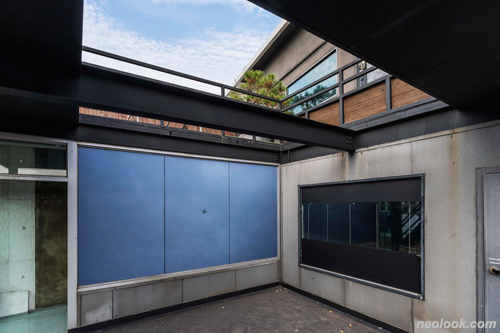
- press Home to unlock展_오에스_2020
별도의 초대일시가 없습니다.
기획 / 이상철 주최 / 아웃사이트 후원 / 한국문화예술위원회
관람시간 / 01:00pm~07:00pm / 월,공휴일 휴관
오에스 OS 서울 용산구 소월로 64-4 (후암동 448-98번지) B1,3층 www.ososos.net
전시를 위해 공간 OS를 처음 방문했을 때 나는 약속 시각을 30분 넘겨서야 그곳에 도착할 수 있었다. 평소 구글맵에 의존해서 길을 찾는데 평면에 가깝게 느껴지는 독일의 길과 오랜만에 찾은 서울의 길은 사뭇 달랐다. 서울역 부근에서 남산으로 이어지는 언덕과 그 사이에 반복되는 작은 샛길들을 미리 염두 하지 못했다. 회현역 주변 언덕을 오르고 내리기를 반복하고 두세 번 길을 잘못 들은 후에야 그곳을 찾을 수 있었다. 공간 OS는 특이하게도 건물의 1.2층을 제외한 반 지하층과 테라스가 있는 3층을 사용하고 있었다. 내게 공간 OS의 상반되는 과잉과 결핍을 나눠 가진 반지하와 3층은 쉽지 않지만 흥미로운 과제로 여겨졌다. 부드러운 빵은 사라지고 바닥의 시트와 겉의 초콜릿만 남은 조각 케이크 같은 이 공간은 내게 묵혀 있던 기억 하나를 떠올리게 했다. ● 처음 독립할 때, 어느 고시원에 방을 보러 들렀을 때였다. 직원은 가장 큰방이라는 방 하나를 추천했다. 그 방은 여느 고시원 방보다 조금 컸고 창 또한 그전까지 본 방들에 비하면 크고 빛이 잘 들었다. 하지만 결점이 하나 있었는데, 방의 중앙에 기둥이 있었다. 그 건물은 경사가 꽤 심한 언덕 위에 있었고 옆의 다른 건물들과 쌍둥이처럼 닮아있었다. 내가 본 방은 복도 끝 마지막 방이었는데 주차장에서 본 것과 같은 기둥이 이어져 방 한가운데를 관통하고 있었다. 기둥은 한 아름보다 컸는데 지름이 한 70cm는 넘어 보였다. 방은 정사각형에 가까웠으며 정 중앙의 기둥 때문에 사방 어느 벽에도 매트리스를 둘 만큼의 공간이 나지 않았다. 창 쪽의 벽 사이에 껴 있던 누군가 손수 만든 작은 책상이 간신히 그 공간의 구색을 갖추게 했다. ● 쉬운 결정의 연속으로 만들어진 그 공간의 낯섦이 내가 쉽게 결정하지 못하게 했다. 창이 없는 나의 방을 하루 더 경험하고 나서야 나는 그 방에서 살아 보기로 했다. 망설임 때문에 오전을 거의 다 보내고 나서야 고시원에 전화를 걸었다. 나는 전화를 받은 이에게 그사이 기둥 있는 큰 방은 나가고 창이 없는 방만 남았다는 답을 듣고 전화를 끊었다.

- 이상철_그의 자유는 과대평가 되었을지 모른다_디지털 프린트_195×345cm_2020

- 홍수현_Not yet titled I_MDF, 각재, LED, LED 컨트롤러, 케이블_110×180×100cm_2020
효율성과 유연성은 압축된 근대화, 산업화를 통해 우리에게 중요한 사고방식으로 여겨져 왔다. 그 배경에는 부족함과 그 극복이라는 시대적 사명이 결정적인 역할을 했을 것이다. 이 효율성과 유연성이 우리가 직면한 결핍을 과잉으로 바꿔 가는 동안 생성된 부정적 산물들은 다시 세대를 거치며 자기혐오와 반성을 고루 경험하고 점차 긍정의 이미지들로 바뀌게 되었다. 천박하고 때로는 분별없고 또 쉽게 끓어오르는 우리의 그것은 다이내믹하고, 스파클링 하며, 크리에이티브 한 것으로 대체 되었다. 지금 우리는 다이내믹하고 스파클링 하며 크리에이티브한 것들로 가득 찬 메트로폴리스에 산다. 장고 없이 놓은 수 뒤로 어쩔 수 없는 수들이 놓이고 무르기를 반복하며 교본에는 없는 판이 만들어졌다. 이'결정과 번복의 흔적'과 '어쩔 수 없음'은 기형적이지만 일종의 독특함을 구축했고 국가, 도시와 같은 공간의 성격뿐 아니라 현재 우리가 소비하는 문화, 예술의 전반을 지탱해 주는 주요 레퍼런스 중 하나가 되었다. ● 이러한 역동성, 독특함은 어쩌면 그 변화의 속도와 그 속도에 의해 빠르게 멀어지는 양극단의 것들이 가지는 낙차의 폭에 근거를 두고 있는 것일지도 모르겠다. 건물은 허물어지며 지어지고 유행은 따라가기도 전에 바뀌며 정렬되지 못하고, 새로운 것들과 남은 것들의 공존이 급기야 아이러니를 드러낸다. 모든 세상을 돌아가게 하는 정반합의 원리는 그 속도에서 어떤 차별점을 드러낸다. 그 흔적은 들여다보는 시점에서 항상 결과로 인식된다. 지하철 노약자석에 앉은 양손 가득 쇼핑백을 들고 배달을 가는 노인의 모습은 전통윤리의 미덕과 자본주의 시스템 안에서의 그들의 위치를 모순적으로 보여준다. 전 세대에 대한 공경과 예우로써 지급되는 교통비는 그들에게 시장에서 교통비만큼의 경쟁력을 획득하게 한다.

- press Home to unlock展_오에스_2020

- press Home to unlock展_오에스_2020
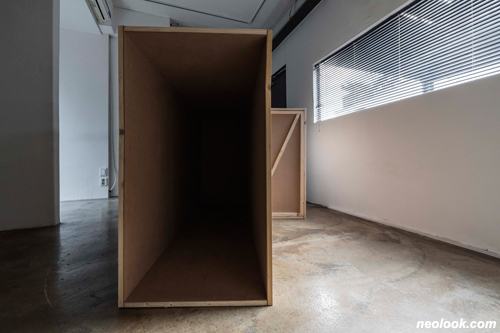
- press Home to unlock展_오에스_2020
내게 집, 한국이라는 곳은 어느 순간부터 과거에 본 기둥이 있는 방과 쇼핑백을 양팔에 가득 안은 지하철의 노인과 같은 양극단이 동시에 존재하는 것을 적지 않게 보는 곳이다. 어쩌면 그것은 더 이상 이곳이 내게 집이 아니라는 의미일지도 모르겠다. 단순히 정서적, 물리적 편안함을 가지게 되는 공간이 아님에는 틀림없고 어느새 일종의 거리를 두고 관찰하는 공간이 되었다는 뜻일 것이다. 어쩌면 나의 작업에서 목격되는 재료들 간의 대립과 관계설정은 과거에 경험한 극단적인 것들의 공존이 무의식적으로 발현되는 것일 수도 있다. 또한 익숙함이 낯섦으로 변모해가는 과정은 비단 공간의 인상에 그치는 것뿐 아니라 그간 익숙하게 여긴 것들과의 새로운 관계설정을 시사하는 것일지도 모른다. ● 전시 'press Home to unlock' 은 핸드폰의 잠금 해제에서 빌려온 문장이다. 독일에서 오랫동안 생활해온 두 작가에게 Home은 이제 더 편안한 안식처와 같은 공간이 아닌 듯하다. 이제 두 작가에게 Home은 일상적인 속도감과 양극단 것들이 주는 자극적인 경험의 익숙함과 낯섦이 교차하는 새로운 설정 창을 열기 위한 버튼이다. ● 나는 주로 다른 속성을 가진 사물들을 조합하거나 공간과의 관계설정을 통해 관습적인 기능 뒤로 숨겨진 새로움을 끌어내길 원한다. 이러한 작업은 주로 내가 마주하는 환경에 반응하는 방식에서 시작된다. 이는 지극히 사적이고 내면적인 사물들을 일상에서 떼어내고 공간에서 존재함의 새로운 당위성을 드러내기 위한 기호적 활용에서 출발하며 나는 이를 위해 이원적 속성을 가진 사물이나 재료 혹은 기호들을 조합하고 그들의 대립적인 속성을 드러낸다. 대립은 강함, 약함과 같은 일반적인 이원 항으로부터 구조적인 것과 비구조적인 것, 단단한 것과 부드러운 것, 영구적인 것과 임시적이라는 세부적 이원 항으로 분화한다. 그리고 이 과정의 결과물들은 다시 주어진 공간과의 관계설정을 통해 그것의 의미를 확대해 나가는데 이러한 사물과 사물, 사물과 공간, 공간과 공간 사이에서 벌어지는 반복적 대립은 인간적인 것과 인간적이지 않은 것의 공존과 이격을 드러내는 데에 목적이 있다.

- 이상철_무제_9개의 메탈프레임, 로프_가변크기_2020

- press Home to unlock展_오에스_2020
이번 전시를 위해 공간을 여러 번 방문한 나는, 높이 150cm의 공간 입구를 겨우 통과할 수 있는 박스 형태의 철조 모듈을 만들고 프레임의 두께와 흡사한 클라이밍 자일을 가지고 연결하고 매듭을 지어 낮은 천고의 지하 공간에 설치했다. 이 구조물들은 공간 안에서 직선과 곡선의 기본적인 조형 요소로 작용하며 선의 겹침을 통해 폐쇄적인 공간 안에서의 대립과 긴장을 관객에게 제공하게 될 것이다. ● 좁은 입구와 낮은 천고를 해결하기 위해 작업을 모듈화하고 조각이면서 동시에 공간의 기둥, 벽과 상호작용하는 건축적인 구조로써 공간과 관계하게끔 설정되었다. 모듈은 좁은 계단과 작은 문을 통과할 당신의 움직임을 근거로 크기가 결정되었고, 다시 머리를 누르는 낮은 천정과 반응하며 쌓여 올라갔다. 또한 이 도시의 비정형적 정렬과 자유로운 엄격함은 프레임의 구조와 끈의 대비로 반영된다. ● 사진 작업 「그의 자유는 과대평가 되었을지 모른다」는 '새의 자유는 과대평가 되었을지 모른다'라는 어느 작가의 메모에서 시작된 작업이다. 드론이 촬영된 이 사진 작업은 3층 테라스의 유리 벽 크기에 맞게 분할되어 부착된다. 사람이 조종하는 드론은 주체이면서도 객체이고 자유와 감시의 상반된 개념이 공존하는 불확정적 상태의 대상이란 점에서 시작된 사진 작업이다. 두 개의 하늘 사진과 하나의 드론이 있는 사진으로 이루어지며 공간과 연동되어 열림과 닫힘의 미묘한 선상에 위치하도록 계획되었다.
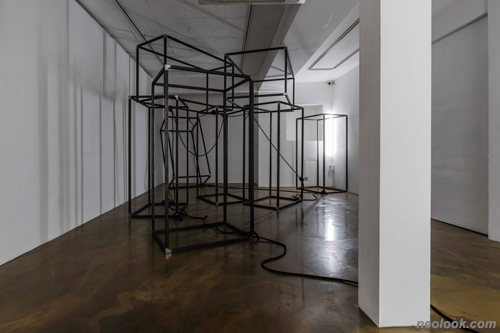
- press Home to unlock展_오에스_2020

- press Home to unlock展_오에스_2020

- press Home to unlock展_오에스_2020
홍수현의 작품은 작품이 설치된 공간의 경험을 전제로 설계 설치된다. 그녀의 작업은 보통 한 번에 파악되지 않는다. 관객이 작업을 관찰하는 동안에 마주하는 공간과 관계 하는 작업의 부분은 주목된 대상으로서의 작업에 비해 결코 작은 영향력을 가지지 않는다. 그녀의 작업은 마치 데이비드 호크니의 사진 작업처럼 배경과 관계하는 부분들의 합으로 이루어져 있지만, 이음새 없이 연결된 것과 같은 느낌을 자아낸다. 관객은 작품 곁을 거닐고 공간, 형태, 빛, 색, 구조와 재료의 물질성과 같은 작업의 다양한 측면을 점차 경험하고 수용할 수 있게 된다. 이 수용의 과정은 작가가 작업을 설계하고 계획하는 단계에서의 경험과 흡사하다. 작가는 전시장을 방문하고 물리적 구조를 파악하기 위해 사진으로 기록하는 과정을 반복하면서 매번 새롭게 공간을 경험하고 사진으로 기록된 공간과 실제 공간 사이의 괴리를 좁혀 나간다. 그리고 이를 통해 전시 공간을 어떤 식으로 작업에 참여시킬지 결정하게 된다. ● 이러한 결정의 과정은 관객이 작업을 이해하는 과정으로 전달된다. 작가는 마치 영매처럼 자신이 경험한 공간과 그것에 관한 기록을 구축하고 되감기 한 후 전시장에 재현시킨다. ● 홍수현의 작업은 공간에 대한 작가의 경험과 이해, 그리고 관객의 경험과 수용에 이르는 어느 연결 짓기의 과정이다. 공간에 작업을 링크하는 작가의 헌신은 배경으로써의 공간과 합쳐져서 상호 역동성을 자아낸다. 이 링크의 완성은 공간에 있게 될 익명의 관객의 몫이며 공간과 작가, 관객 사이에서 발생하는 역동적 간섭은 교훈적 또는 설명적인 의도 없이 이루어진다. 작가는 이 링크를 통해 열려진 또 다른 이계적 공간과 관객 간의 직관적 상호작용을 위해 예술적 설정 단계에서 전달되는 관습적 내용과 메시지를 제거한다. ● 이번 전시의 홍수현의 작업 「Not yet titled 2」는 일상에서 흔히 볼 수 있는 광고 박스의 형태를 가지고 있다. 벽을 마주하고 세워진 박스는 벽을 향해 빛을 뿜어 주위 공간을 밝힐 뿐, 어떤 정보나 이미지도 제공하지 않는다. 그녀의 작업은 때로 공간의 구조와 다른 작업을 빛으로 안기도 하고 그림자로 그들을 중첩시키기도 하면서 하나의 전체를 만든다. ● 전시장 3층에 설치된 홍수현의 작업 「Not yet titled 1」은 하나의 조각이면서 동시에 하나의 공간이다. 작업 안에 설치된 조명은 꺼졌다 켜지기를 반복한다. 빛의 매개가 되는 에너지의 흐름과 단절이라는 상황에 의해 발생하는 이 단순한 반복은 1m 높이의 작은 통로 안에 일종의 대립점을 제시하며 꺾인 벽 뒤로 또 다른 공간으로의 확장을 꾀한다. ● 이 전시는 두 작가가 Home (집, 한국, 서울)을 대하며 마치 높은 댐에서 수문을 열고 낙차에서 에너지를 얻는 것처럼 관념과 현실적 감각 사이의 괴리에서 발생하는 에너지를 사용해 만드는 전시가 될 것이다. 두 작가는 또한 서로의 작업이 가질 수 있는 접점을 공간과의 관계설정으로 상정하고, 각자의 작업이 공간을 매개로 한 다르면서도 잘 짜인 리듬감 있는 이야기 구조를 가지기를 바란다. 이 이야기는 어떤 메시지와 관련된 것이 아니다. 공간 OS 앞에서 잠시 숨을 고른 당신이 계단을 내리고 오르고 작업 앞에서 잠시 멈추고 돌아보고, 내려다보고 서두르고 쉬어가는 당신이 만드는 이야기이다. ■ 이상철
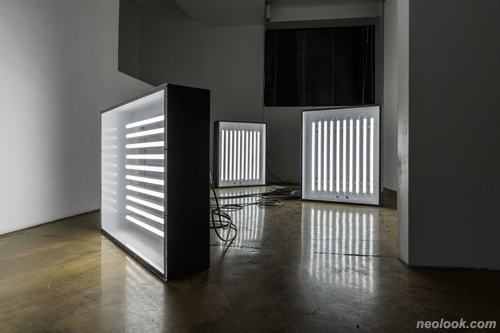
- 홍수현_Not yet titled II_스틸, 아크릴, LED, 케이블, 멀티탭_각 60×75×15cm_2020
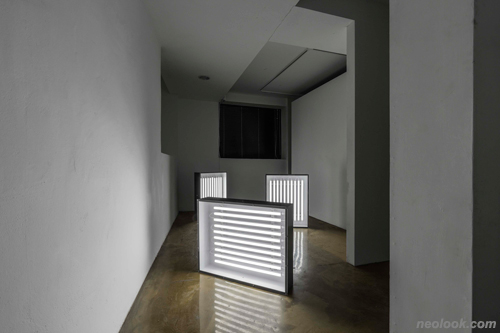
- press Home to unlock展_오에스_2020

- press Home to unlock展_오에스_2020
I was half an hour late when I first visited OS for the exhibition meeting. As visiting Seoul in a long time, navigating with Google Maps as usual felt somewhat different from navigating in Germany, where the distance feels closer due to the flatness of the land. ● I didn't bear in mind the hill leading to Namsan mountain from Seoul Station and the repeating small byways. I arrived after climbing up and down the sloped alleys near Hoehyeon Station and getting lost two, three times on my way. Surprisingly, OS is located on the ground floor and the third floor with a terrace, skipping the building's first and second floor. The contrast of excess and deficiency shared on the ground floor, and the third floor of the space seemed to be a task not easy, yet interesting. This space, like a slice of cake with the frosting and the bottom paper but no moist bread in the middle, reminded me of a bygone memory. ● I was looking for a goshiwon (low-cost boarding housing) to rent when I first left my parents. The agent recommended the biggest room on the list. It was slightly bigger than other goshiwon rooms, and the window was more significant than the others I had viewed so far with good sunlight. However, the room had a flaw: there was a pillar in the middle of the room. The building was located on top of a steep hill, looking like other buildings nearby like twins. The room was at the end of the corridor, and the pillar that I saw in the garage was stretched to penetrate the centre of the room. The column was larger than an armful, seemed full 70cm in diameter. The room was almost square, but there was no space for a mattress on any single corner because of the post in the middle. A hand-built desk was crammed by the window, which made the space barely look like a room. ● The awkwardness of the room as the result of a chain of easy decisions made it difficult for me to make my mind. After spending another day in my room with no window, I decided to give that room a shot. Having wasted all morning hesitating, it was in the afternoon that I determined to call the goshiwon. I hung up the call to an answer that the room with a post was already sold out, and only rooms without windows were left. ● Efficiency and flexibility have been considered a significant mentality since compressed modernisation and industrialisation. Insufficiency and the periodic mission to cope with it must have played essential roles as the background. While this efficiency and flexibility had been converting the confronted deficiency into overabundance, the negative byproducts of the process have gone through self-loathing and self-reflection over the generations, and gradually transformed into images of positivity. ● Those of ours that are shallow, indiscreet, and sometimes easy boiling have been replaced by the dynamic, the sparkling, and the creative. Now, we are living in the metropolis full of the dynamics, the sparklings, and the creatives. Those poorly thought moves were followed by the repetition of inevitable steps and their cancellations, and thus here we are with a situation not written in the playbook. The 'trace of decisions and reverses' and the 'inevitableness' are contorted. But somehow they established a sort of peculiarity and became crucial references that sustain not only the character of our space like the nation or the city but also the entire art and culture that we are currently consuming. ● Such dynamicity and peculiarity might be based on the speed of the change and the gap between the extremes that rapidly drift apart due to the speed. Buildings are collapsed and built, trends shift before we even keep up with them, and the coexistence of the new and the leftovers reveals irony. The logic of thesis-antithesis-synthesis that keeps everything moving become differentiated with the speed. The trace is always recognised as the outcome at the point of observation. A senior sitting on the elderly-seating in a subway, carrying handfuls of shopping bags to deliver, ironically demonstrates their status within the system of capitalism and the virtue of traditional ethics. The courtesy subway rate provided as respect and honour for the previous generation makes them win a competitive advantage in the market as much as the transportation expense. ● At some point, home, Korea have become a place where I often see the coexistence of both extremes like the room with a post that I saw a long time ago and the elders in subways delivering hands full of shopping bags. Perhaps the fact implies that this is not my home anymore. It is clear that it is no longer a space where I feel comfortable mentally and physically. Moreover, I believe it means that it has become a space that I observe with a certain distance. Perhaps the contrasts and relations set among the materials in my works are the subconscious revelations of the coexistence of those extremes that I witnessed in the past. And maybe the process in which the familiar transforms into the unfamiliar is not limited in suggesting a mere impression of the space but suggesting a new set of relationship with what used to be familiar. ● The exhibition title press Home to unlock is a phrase borrowed from the unlocking of a cellphone. For the two artists who have lived many years in Germany, Home is not a space like a cosy shelter. For them, Home is a button to open a window for a new setting where the familiarity and the unfamiliarity of the mundane pace and stimulating experiences intersect. ● I usually combine things of different properties and set their relationships with space to educe novelties hidden behind the conventional functions. Such work starts from the way I respond to the environment I encounter. It begins with symbolic conjugation that aims to dislocate deeply private and internal things from the mundane and to reveal new rightfulness of being in a space. For this, I combine things, materials, or signs of dual properties and uncover their confrontational attributes. The opposition branches from ordinary binaries, such as the strong and the weak, into detailed binaries of the structural and the non-structural, the hard and the soft, the permanent and the temporary. And the consequences of such process expand their meanings by setting relations with the given space. Such repeating opposition of thing against thing, thing against space, space against space have their purpose on disclosing the proximity and the distance between what is humane and what is not humane. ● After visiting the space several times for this exhibition, I made box-shaped steel modules that could barely pass through the 150cm-high entrance of the gallery, connected and knotted them with climbing rope that is as thick as the steel frame, and installed them on the ground floor space with a low ceiling. These structures function as fundamental formative elements of straight lines and curves. And the overlapping of the lines would provide opposition and tension in the closed space. ● I modularised the work to deal with the low ceiling and the narrow entrance, and arranged them to relate with the space as architectural structures that interact with the pillar and the walls of the space. The modules are scaled based on the movement that you would make when you pass through the narrow stairway and the small entrance, and then stacked reacting to the low ceiling that is pressing your head. Also, the atypical array of the city and its free rigour are reflected in the contrast between the structure of the frame and the string. ● The photo piece 'His freedom may have been overestimated' was motivated by a memo of an artist that wrote 'Bird's freedom may have been overestimated.' The photograph capturing a drone is cut to fit the glass wall on the third-floor terrace and attached to it. The work started from a point that a drone, driven by a human, is simultaneously a subject and an object, an object of uncertain state in which the conflicting idea of freedom and surveillance coincide. Consist of two images of the sky and an image of a drone, the work is planned to be located on the subtle line between openness and closeness, interlocking with the space. ● Soo Hong's work is planned and installed based on the premise that the work would be experienced in the space installed. Her works are usually not grasped at once. The part of her work related to the space that the viewers encounter while observing the work is not less influential than the work focused as the object. Her work is composed as the sum of the parts that relate with the backgrounds, like in the Hockney's photo pieces, yet they seem seamlessly connected. The viewers walk along with the work to experience and accept various aspects of the work, such as space, form, light, colour, structure, and the properties of the materials. This process of acceptance resembles the artist's experience during the planning and designing of the work. By repeatedly visiting the exhibition space and taking photos to understand its physical structure, the artist newly experience the space every time and narrows the gap between the space in the photo documentation and the space as in real. And through the process, she determines how she will include the space in her work. Such a decision-making process is passed on to the viewers' process of understanding the work. The artist, like a psychic, establishes documentation of the space and her experience of the space, then rewinds and plays it in the space. ● Soo Hong's work is a process of connection that leads to the artist's experience and understanding of the space, as well as the viewers' experiences and acceptances. Her devotion to link the work to the space evokes mutual dynamic as it merges with space as the background. Completing the link is the anonymous viewers' share. The dynamic interference among the space, the artist, and the viewers is established without instructive, expository intentions. The artist eliminates conventional contents and messages on the stage of the artistic setting for a direct interaction between the viewers and the extraordinary space unlocked by the link. ● Hong's work Not yet titled 2 shown in the exhibition is in the form of an advertisement box that we see everywhere. The box facing a wall brightens around it by emitting light onto the wall, but it provides no information nor image. Her work, at times, embraces the structure of the space and other pieces with light, while also overlapping them with its shadow. And thus it makes a whole. ● Not yet titled 1 placed on the third floor is a sculpture and simultaneously a space. The light installed inside the piece repeatedly turns on and turns off. This simple repetition as a result of flow and break of energy, a medium of light, provides a sort of conflict point inside the 1m tall corridor and attempts to expand into another space behind the bent wall. ● Two artists aim to make the exhibition utilising the energy generated from the gap between the idea and the realistic sense facing Home (home, Korea, Seoul) as if a tall dam gains power from the difference in elevation by opening up its floodgate. They present the point where their works connect to each other's as the setting of relation with the space, and wish their works each structure unique and tightly woven narratives. This narrative does not refer to any message. It is your story: written by those who are catching their breath in front of OS, climbing up and down the stairs, pausing in front of the works, looking back, looking down, rushing, and stoping. ■ Sangchul Lee
Vol.20201106i | press Home to unlock-이상철_홍수현 2인展
